Are Heated Floors Right for You?
Heated floors are easier to intall and more cost effective than ever before. If you’ve been thinking about remodeling your home or adding some new features, heated floors should definitely be on your list of considerations.
Underfloor heating systems are a great way to bring a touch of comfort to your home. They feel great on feet that are always cold, and they provide relief from low temperatures and drafty spaces.
While you may not think you need underfloor heat in Tallahassee, Florida, they are actually a great solution for chilly fall and winter days.
They will cut down on your heating bill since they serve as another heat source in your home. And they feel downright luxurious.
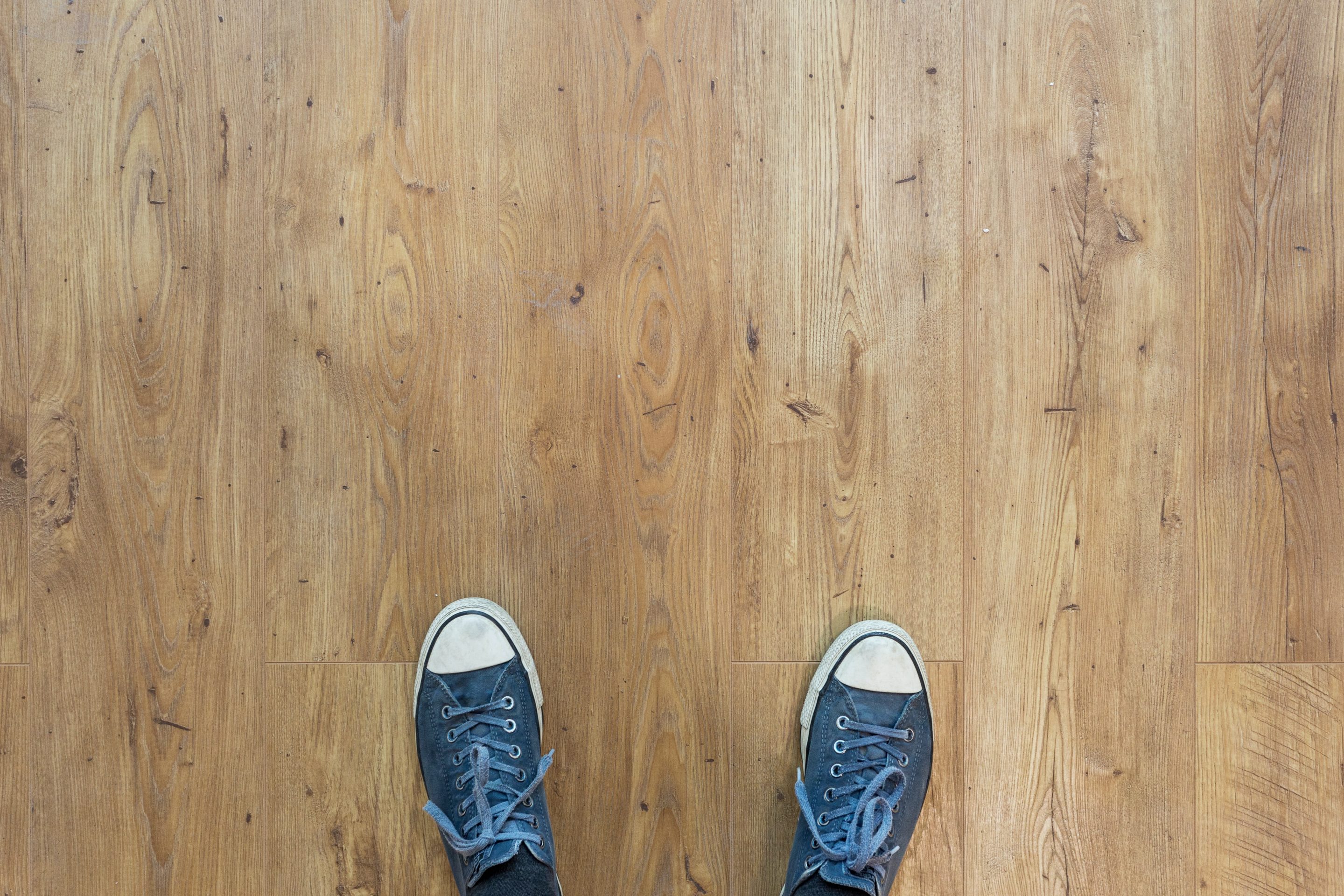
Underfloor heating can help keep the thermostat lower while still providing comfort
McManus Kitchen and Bath is a full service remodeling company with an in-house design team and showroom right here in Tallahassee, FL.
We work exclusively with homeowners to help them remodel using a design-build approach that saves time, avoids confusion and creates better results.
What is a Heated Floor?
A heated floor system, also known as radiant underfloor heating is a system where either electrical wires or hot water pipes are installed under the flooring. As they heat up, the floor itself heats up to a pleasant, warm temperature.
A n underfloor heating system is an excellent investment. It’s a cost-effective way to heat your home while simultaneously reducing your carbon footprint.
It is ideal for those who wish to maintain their indoor temperatures year-round with minimal changes in household temperature settings, or for those who live in areas where the temperature drops significantly.
Heated floor systems can be installed under any type of flooring, including tile, stone, or laminate.
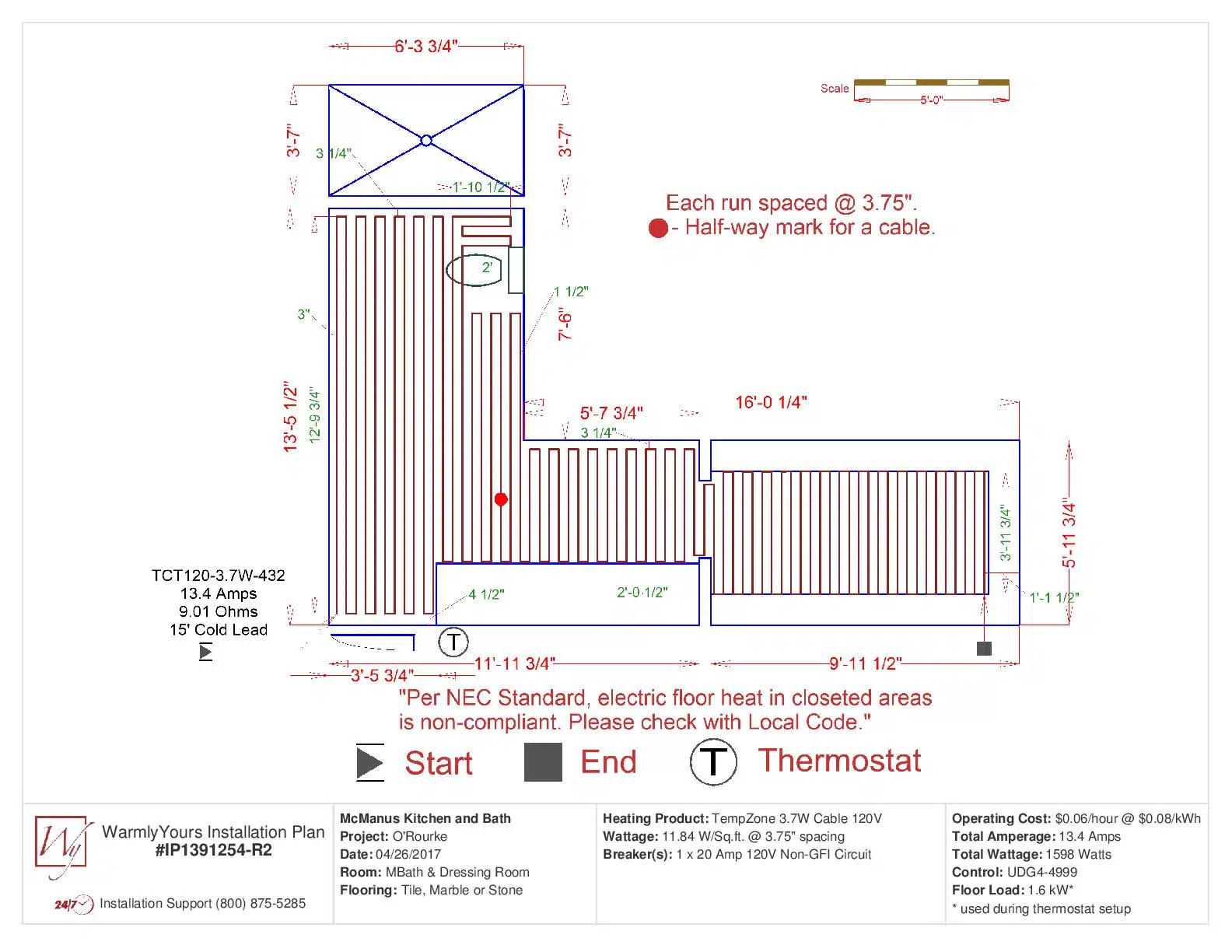
Layout for a heated floor system in a master bath.
Want Some Inspiration In Your Inbox?
How do Heated Floors Work?
When it comes to heated floor systems, there are two main types: hydronic and electric. Electric floor systems are the most common type of floor heating.
Electric heating systems are the easiest to install and the system we recommend.
Electric Systems
There are two basic types of electric systems. One uses an underlayment and loose wire, the other is a pre-made mat with the wires built in.
The first system uses plastic underlayment with grid system in which rubber coated wires are run. The wires are connected to a thermostat to conrol the floor heat.
The other electric system is a woven mat with wires built into the matting. Both systems work similarly that advantage to the underlayment system is it can be customized to exacly match your space. The woven mat system come in set sizes.
These systems provide instant heat in those areas and can be controlled remotely by a thermostat or programmable controller to avoid excess heat exposure if necessary.
Hydroponic Systems
Hydroponic heated floors are a type of floor heating system that uses water to radiate heat throughout the room.
Pros and Cons of Electric Vs Hydoponic
While electric systems are more common, hydroponics systems for floor heating are becoming more popular. They are a lot more efficient and can heat up the room faster. This is because they use water as a heat source, which is more efficient than electric heating.
Electric floor heating systems are less expensive to install and maintain, but they don’t provide as much warmth as hydroponic systems.
Electric systems are thinner than hydroponic ones so your less likley to run into issues installing it when remodeling.
You can talk to your contractor about which type of heating system is best for your situation and goals.
Where to use it
Underfloor heat is often used in kitchens, bathrooms, and bedrooms over garages or other unheated spaces, but they can be used just about anywhere.
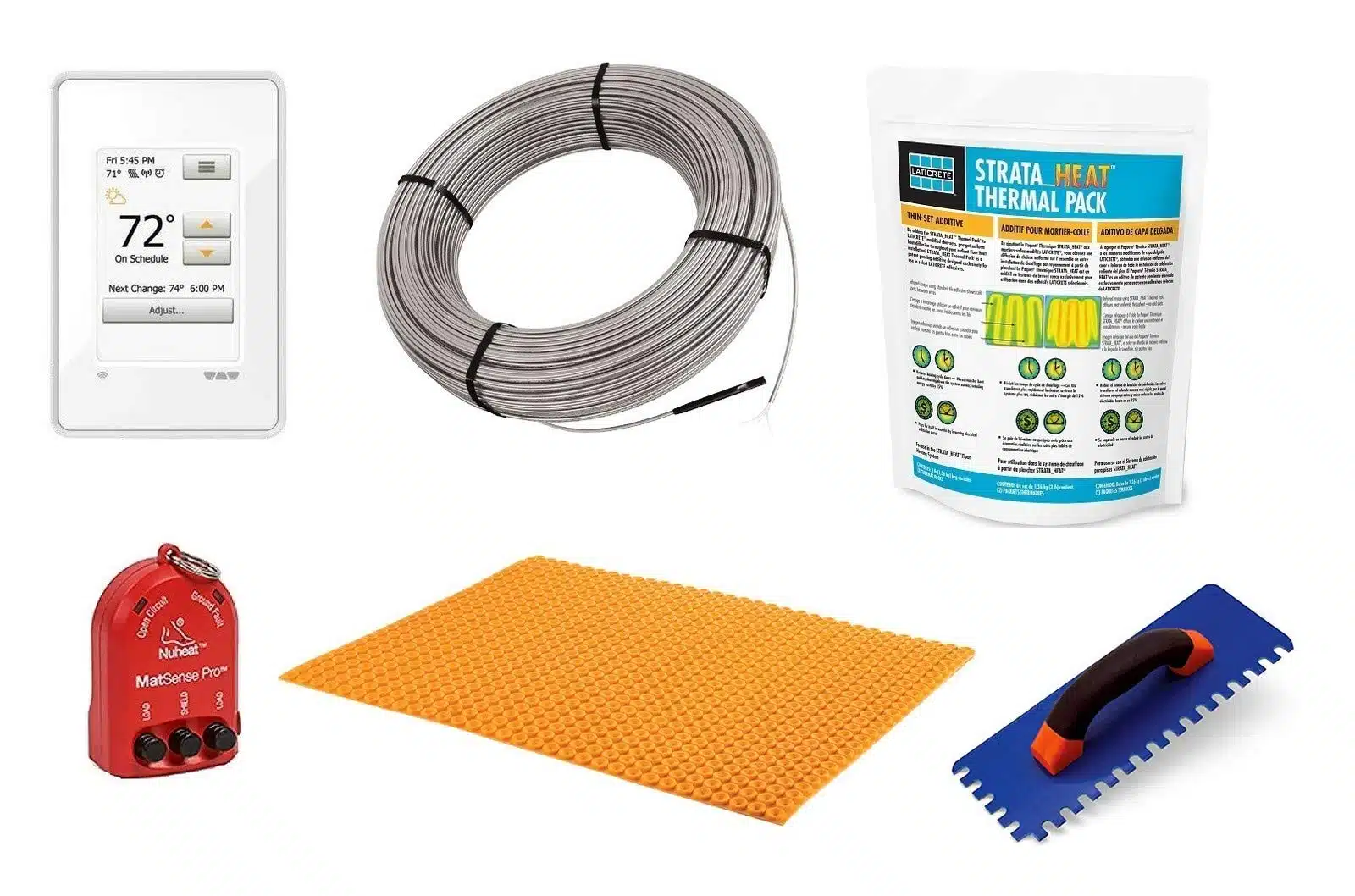
Components of an electric heated floor system
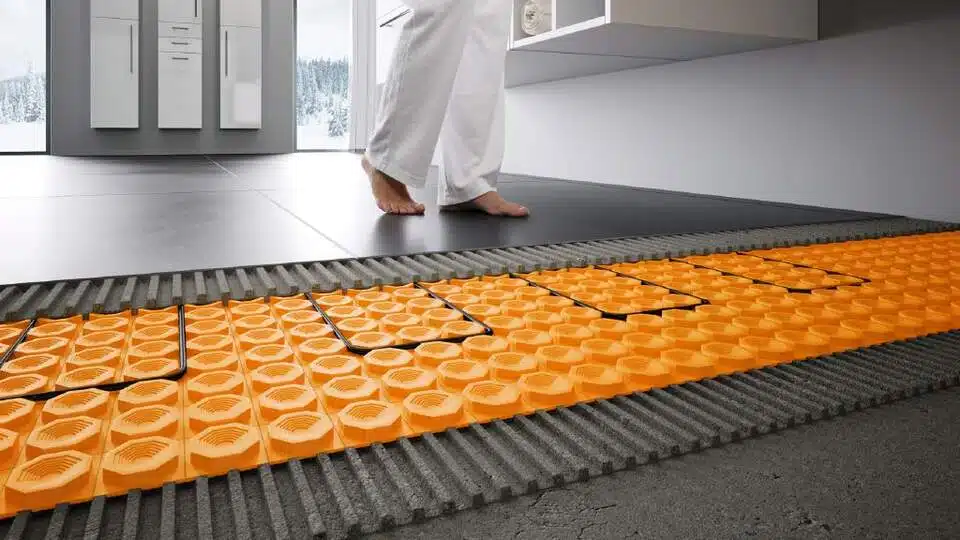
Dittra Heat, by Schluter Systems, is a popular option
What Are the Advantages of Heated Floors?
While there are always pros and cons to any home remodel including heated floors, there are many reasons they may be a great investment for you. The only real disadvantage is the added costs, which might not be as much as you think.
They’re more energy efficient, they can increase the value of your home, they can make your home more comfortable, and they’re easy to install. Other advantages include the following:
They offer uniform heating:
They are a great way to keep your feet warm and reduce the amount of energy that you use on heating. The temperature of the floor can be set to a uniform temperature, meaning that there is no variation in the heat. This means that you won’t have to worry about feeling cold in certain areas of your home.
They provide comfort:
Radiant heating provides warmth to your feet and can increase your overall comfort. They’re also great for people suffering from chronic pain, relieving their discomfort by providing warmth.
They are low-maintenance:
Heated floors are easy to maintain, which is a great option for homeowners who don’t want to spend a lot of time and money ensuring the floors are in optimal condition.
They are energy efficient:
They are also a great way to keep your home warm without using a ton of energy. With traditional heating systems, the air is warmed and rises to the top of the room, leaving uneven heat in your home and wasting energy. Heated floors don’t require as much energy to heat up a room, and because these floors are heated directly, less energy is lost.
They are compatible with all types of flooring:
They can be installed underneath any type of flooring, though when installing them under wood or laminate there are specific products and underlayments that need to be used.
They are non-allergenic. Unlike traditional heaters, floor heating doesn’t move air. This means that they don’t disturb those with dust or other allergies.

No one enjoys heated floors more than our furry friends!
What Are the Disadvantages of Heated Floors?
Heated floors are great in most situations but have a few disadvantages. Cons of heated floors include:
They require you to replace your old flooring:
You’ll have to get rid of your old flooring. This isn’t a problem if you were already planning a remodel, but it might be a hassle if you weren’t.
If you are planning to redo your floors, choosing flooring that will last and installing a heating system underneath is a great way to set yourself up for years of low-maintenance beauty and warmth.
They take some time to install:
The process for installing underfloor heating isn’t very complicated, but it does take some time. The first step is to remove any old flooring. Then the heating system is laid. This includes both the pipes and the mat.
Once this has been done, a thin layer of insulation between the heating mat and your new flooring will be added, and then the new flooring will be installed on top.
They can cause issues with floor height:
Underfloor heat systems can add 1/2″ or more to the thickness of your floor assembly. This can cause issues at doorways or under kitchen appliances.
Cost:
Heated floors cost roughly $15 – 20 a square foot for all the labor and materials. That’s on top of your flooring costs which could be $10 – $20 installed as well.
For small area like a bathroom that might only add $1000 to the cost of the project. But for a whole home it could be a deal breaker.
You also don’t have to install underfloor heating everywhere. For example instead of doing it in the entire bathroom you could just put in in front of your vanity.
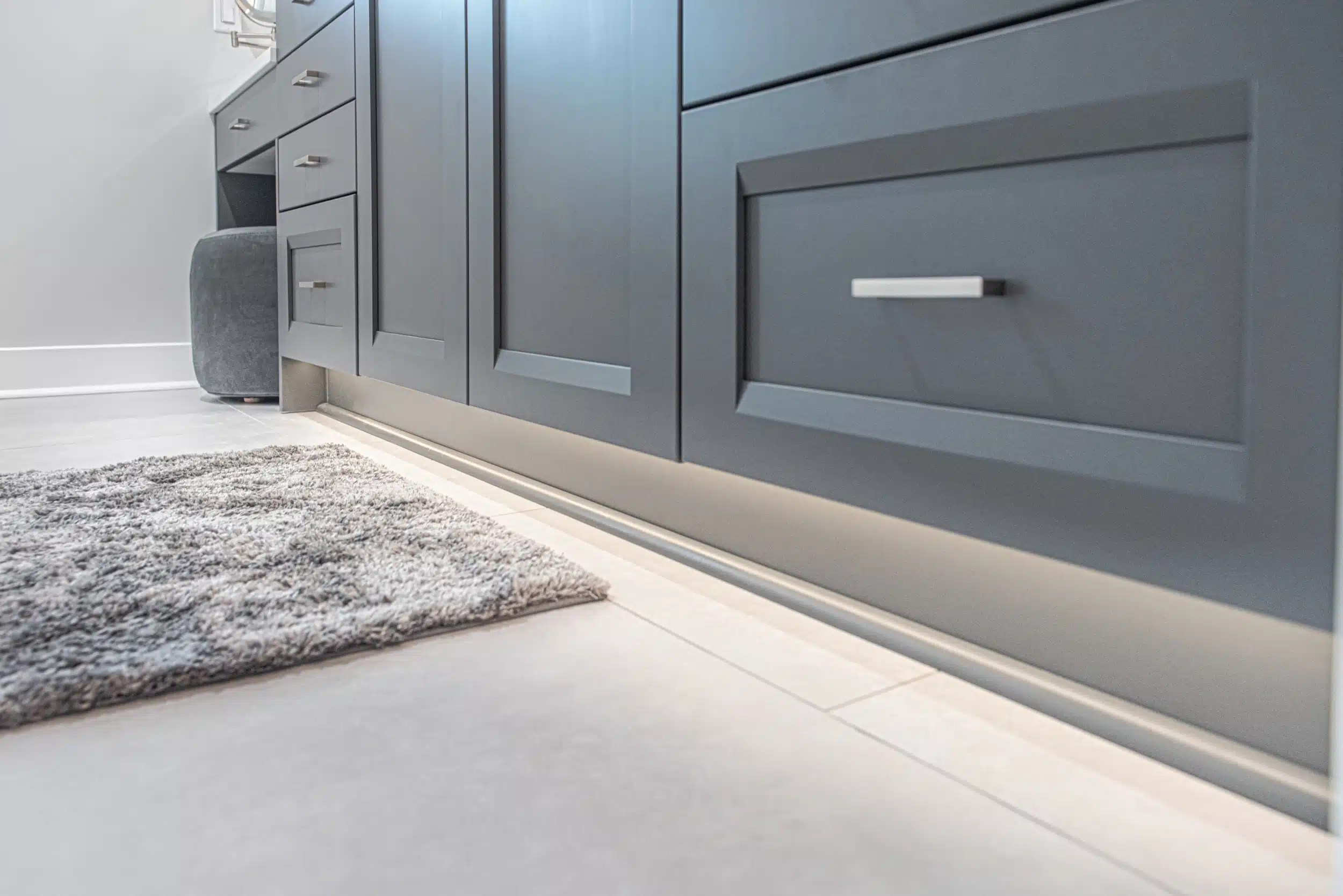
You can put underfloor heat just in specific areas, like at your vanity
Heated Floors: More Considerations
Type of Flooring
When considering an underfloor heat system for your home, it’s important to consider the type of flooring you already have or the type you want to install. That’s because different types of floors conduct heat differently.
For example, ceramic tile and stone floors are good conductors of heat. They will feel warm to the touch even if the room is not heated. Hardwood floors are not as good at conducting heat, but they still feel warm when the room is heated.
Also, consider the floor’s thickness. You want it to be around 15mm thick to allow heat to pass through. Also consider that if you have hardwood floors, you may want to install a thicker flooring system so that your wood flooring isn’t damaged by moisture and condensation.
If you have a mixture of different types of floors in your home, it’s best to install radiant heating in one section at a time so that you can adjust the temperature accordingly
Reliable Brands
Choose a name you can trust and consider the brand name of a floor heating system before making a choice. For electric systems we typically install Dittra Heat or Warmly Yours.
Size of the Floor Area
Consider the size of the floor area you’re heating when installing heated floors. If you have a small room, it’s best to install radiant floor heating that’s more energy efficient and provides an even heat distribution for all areas in your home. This will also help you save money on your utility bills in the long run.
The size of your home also determines how much space you need to install heated floors in order to keep your entire house warm during winter months. If it’s a bigger house, it is best to install radiant flooring that heats up larger areas of space with less electricity usage than other types of heating systems.
Type of Insulation
It’s important to think about the type of insulation you’ll be using for your floor heating system. There are many different types of insulation that you can use, and each one has its own benefits and drawbacks. Your contractor can help you decide what is best for you. Some options include:
Foam-based insulation:
This type of insulation is an environmentally friendly and cost-effective way to insulate your heated floors.
Polystyrene-type insulation:
This is a popular choice for heated floors. It provides an R-value of 5 per inch, and is easy to cut, shape, and install with adhesive.
Radiant heat mats for insulating heated floors:
Radiant heat mats are a great way to insulate heated floors. These mats work especially well in cold climates where the ground is often below freezing. They also work well in homes with concrete and stone floors which, although they maintain an even temperature, tend to be very cold to the touch.
Radiant heat mats are thin sheets of insulation made of aluminum foil. They can be purchased at hardware stores and installed under floorboards, along walls, and on other surfaces to radiate heat.
Radiant mats can be used in conjunction with hydronic heating systems, providing the benefits of radiant floor heating without the cost of installing a whole new system.
Heated Floors Can Be a Great Addition to Any Home Remodel
Heated floors are a great way to stay cozy all year long. They can help your home stay at a consistent temperature and can be an eco-friendly and wallet-friendly way to keep you and your family warm. Besides, who doesn’t enjoy the luxury of their feet hitting a warm floor when they wake up every morning?
If you have questions about whether or not heated floors are right for your Tallahassee home remodel, we’re here to help. We can talk you through the pros and cons and help you choose the right type of heating source, flooring, and other key elements of your heated flooring system that work best for your needs. Contact us today and let us help you make your home cozy and warm.
